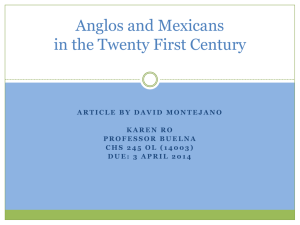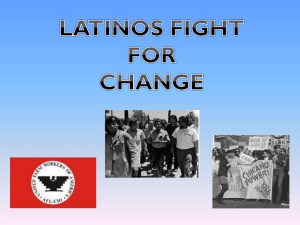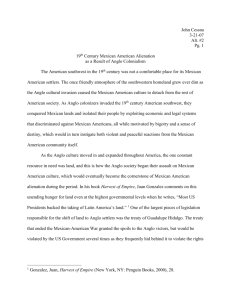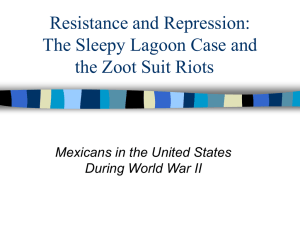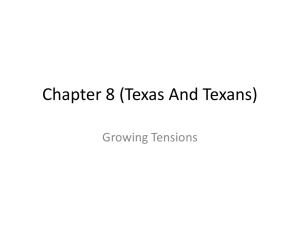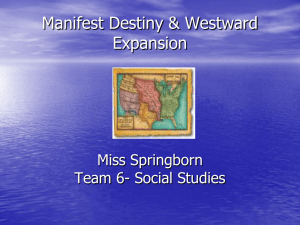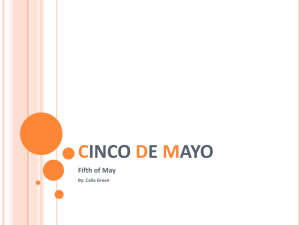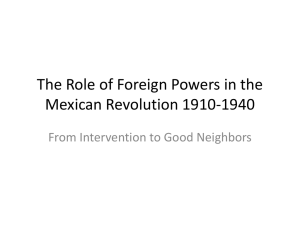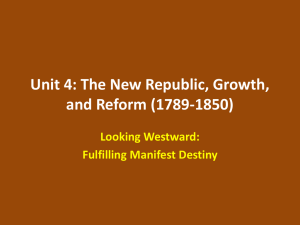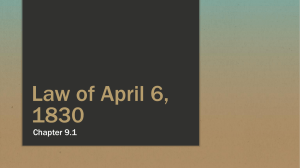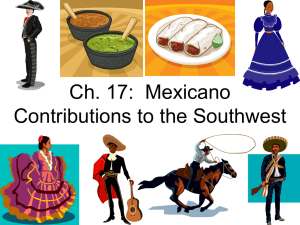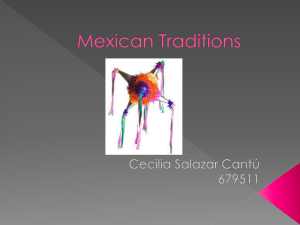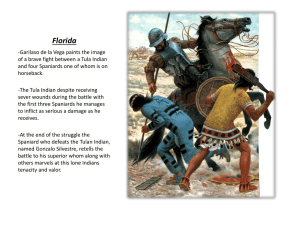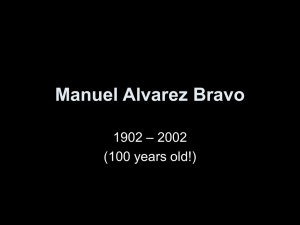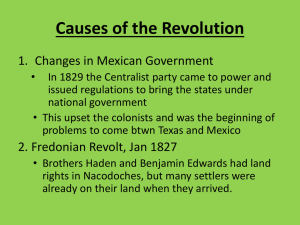anglos and mexicans in the 21 st century by
advertisement
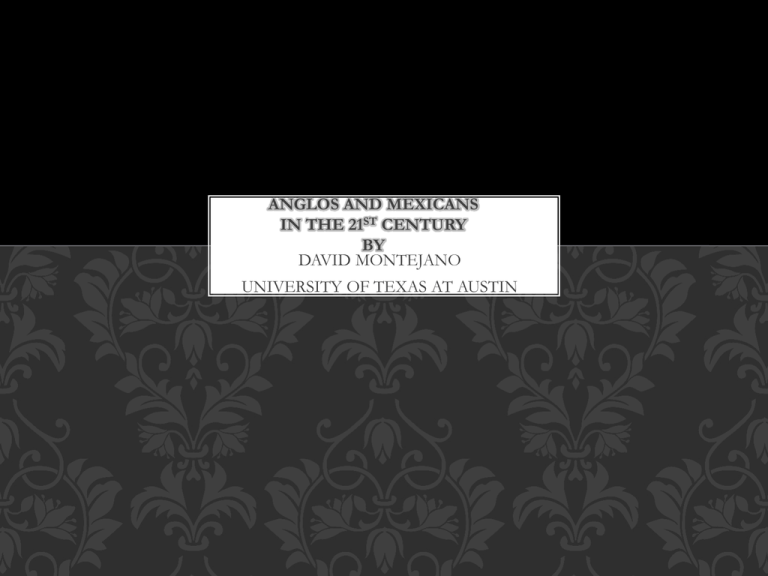
ANGLOS AND MEXICANS IN THE 21ST CENTURY BY DAVID MONTEJANO UNIVERSITY OF TEXAS AT AUSTIN • David Montejano wants to explore various futures we may face • Montejano took a research trip in the State of Zacatecas, Mexico In his research trip, he found a village called El Saucito. The village has pigs. He saw a Coca-Cola truck and followed it. As he followed the Coca-Cola truck, he was struck by the realization that this truck signified the larger ties this community had with a world economic system, very much as the deaths of their young men in that West Texas desert also signified these larger ties. As the truck passed the crumbling walls of an abandoned silver mine that lay outside of town--a silver mine dating back to Colonial times--he was also struck by the fact that this village had been part of a world system for centuries. • This experience will allow Montejano to say comments about further ethnic relations in the Southwestern United States. Before he talks about the future, he talks about the current Mexican-Anglo relations in the Southwest • The current ethnic situation is one of political integration, which is granting effective citizenship to the Mexican American • Significant Mexican American electoral activity was not confined to New Mexico • Mexican Americans were significant players in California and Texas state politics and in national politics • Political integration was a result of shifting class politics during the post-World War economic boom • Political integration does not signify any kind of assimilation of the Mexican American people • Segregation was a solution to the Negro problem of the South and the Mexican problem of the Southwest • Montejano talks about segregation and its downfall • The rationale and political orientation of segregation was grounded in the agricultural developments of the region • Growers made social segregation “natural” • The National Labor Relations Act of 1935 excluded agricultural workers • Ethnic complexity was organized • “White” ethnic growers and their families live on one side and “Brown” ethnic workers and their families live on the other side • The gradual demise of segregation in the Southwest and the start of World War II upset the labor practices Anglo growers developed to weaken the Mexican farmworkers • Soldiers and factory workers of all “nationalities” were needed for fighting in the war • • • • • • • • • • After the war, there was displacement of farm workers and family farmers The segregated farm order fell out as farm workers and small farmers moved to the cities Segregated order became a hollow shell A new urban business elite emerged as the dominant economic and political force in the region This new elite did not require rigid labor controls for survival The Anglo business elite followed Jim Crow practices He/she was forced to abandon the Jim Crow practices because of pressure from below and outside Mexican American veterans wanted equal rights The Anglo business elite became more responsive as Mexican Americans leveraged their position as workers, voters, and consumers to secure concessions and “rights” Result was desegregation of the cities in the greater Southwestern border in the 1950s • There was partial desegregation in the cities and a thorough segregation in the farm areas • Jim Crow segregation was in effect as long as Mexican-American activists in the urban areas and the rural areas worked separately • Mexican Americans in the region were considered second-class citizens • There were farm worker strikes in California and Texas • There was a renewed land grant struggle in New Mexico • These actions caused a broad civil rights mobilization • There was also a second movement from below to put pressure on the racial order • The immense pressure from below laid the basis for politics of inclusion • Chicano movement developed • Eventually it dissipated because of external and internal pressures • The external pressures were the “big stick” of police repression and the “carrots” of reform • The internal factors inexperience, inadequate analysis, lack of internal democracy, and the failure to build “counter-hegemonic” institutions • Chicano movement was complex • United People’s Party was formed • United People’s Party is also known as La Raza Unida • It is a populist, nationalist political party that wanted to challenge Jim Crow democrats in Texas • There was a party called the United Farm Workers • It was led by Cesar Chavez • The California Agricultural Labor Relations Act extended the labor rights of “urban workers” to agricultural labor • Political status of the Mexican American in California was changing • There was a partial opening of universities to the Chicano youth • The partial opening of universities led to an expanded Mexican American middle class • There is a white collar occupation • The amount of unskilled people in Texas declined • The amount of lower class people in California declined • • • • • • • • • Mexican-Anglo relations transformed from segregated order to a present-day integration We have a form of “political integration” We cannot assume that we will have political integration forever “Political integration” means that Mexican Americans have access to the political arena Montejano talks about some dynamics that will affect this “inter-ethnic” understanding in the near-future and how it will affect our next generation We have to look at 2 factors The first factor is the changing global arena. The United States is in a period of economic decline today The second factor is the changing demography of the Southwest • • • • • • • • The United States was a rising world power The rise of world power gave the United States wealth and political confidence Race segregation was challenged Race segregation ended The United States today faces the dilemma of all great powers Paul Kennedy points out the dilemma of all great powers Paul Kennedy wrote a book called The Rise and Fall of Great Powers His book gives the view of a national security advisor, one who is concerned about the nation’s external interests • Kennedy wants the United States to have a strong military posture and a strong economic posture in the world arena • Kennedy turned to Latin America and found some troubling challenges to the United States national interest • He said that if an international debt crisis happens anywhere in the world, most likely it will begin in this region. • There will be very serious consequences to the global credit system and American banks • Mexico is on the verge of bankruptcy • Kennedy pays very little attention to American domestic policies • He stated that the lack of class politics in the United States since the 1930s was caused by this country’s overall growth during the establishment of the pax americana • The poorest one-third of American society has not been mobilized to become regular voters and that also led to the lack of class politics in the United States • Limited democracy is a good thing • “Too much” democracy may be a bad thing • Kennedy referred to the high birth rates of American minorities • Kennedy said that it would be unwise to assume that the prevailing norms of the American political economy would be maintained if the nation entered a period of sustained economic difficulty • Bruce Babbit is the former governor of Arizona • Babbit observed that “the Southwest is being Hispanicized” • The Southwest today points to new realities: problems of population pressure, massive movements of peoples across uncontrolled borders, the problems of birth control and cultural levels in education. • Richard Lamm is another ex-governor • He argued that Blacks and Hispanics contribute to extraordinary crime, joblessness, and illiteracy rates • Lamm said “We are heading for an America in which we will have two angry, under-utilized and under-educated, frustrated, resentful, jealous, and volatile minority groups existing unassimilated and unintegrated within our borders.“ • The demographics of the United States and the Southwest are changing • David Hayes-Bautista, Werner Schink, and Jorge Chapa wrote a book called The Burden of Support: Young Latinos in an Aging Society • Hayes-Bautista says that the Latino population in California will equal the Anglo population in the year 2030 even if we assume no additional immigration • The growth of the Latino population will cause a new social division in California and in the Southwest along generational ethnic lines • Around 70% of the wage earning work force will be Latino • If these two simultaneous trends happen, our near future will promise to be a challenge: the aging of a well-educated Anglo baby boom generation and the growth of a much younger, less educated Latino population • Hayes-Bautista proposed 2 possible scenarios • The first scenario is a very grim repressive portrait of a society on the brink of anarchy • “Visible police protection was demanded, and when not provided by public entities, privately retained security forces filled the gap. In urban areas, the remaining elderly Anglos adopted all sorts of security measures, huddling behind high, tamper-proof fences, with gate guards, canine patrols, entry and exit checks, and thick grills on windows to protect them.” • Paychecks of Latinos were used for funding the elderly • Federal income tax rates were high enough to cover the costs of other elderly programs as well as the continuing costs of expensive military systems. • There weren’t a lot of benefits being returned to the young workers • The school system was doing bad • Spending money on roads, water systems, and building systems dwindled to almost nothing • “By the turn of the century, it had become common to see unpaved roads in the Latino sections of town and to find hoses and electrical lines snaking along the ground, sometimes for miles, to provide water and electricity in areas where no other form of service was available. • • • • • • • • • • • The young Latino community protested their living conditions There were strikes in assembly plants. Security walls were put afire More guns were sold in the elderly area The second scenario is scenario that can be realized if we make the necessary commitments to education and affirmative action policies. The factors identified contribute to the demise of segregation in the Southwest. The first factor is the emergence of a Mexican American middle class Well-educated Latinos were produced Second factor is the re-emergence of the social liberalism of the sixties and seventies. The best guarantee of support for the elderly would be an investment in the younger Latino population Alliance between the Mexican American middle class and Anglo business class is a type of alliance that could possibly preserve the "inter-ethnic compact" in the coming decades. • Montejano asks us what possible futures await us * Using the estimation of Hayes-Bautista, we have a narrow policy window of some 15-20 years to decide in which general direction we wish to travel. * The struggle between inclusion and exclusion continues * Some segments of the Anglo community, are campaigning for "English-only," and for the preservation of "Western Civilization." Other segments are campaigning against the Voting Rights Act, against Affirmative Action, against immigrant rights, and against "multicultural" education. * A large underclass is deprived of opportunities * Our future depends on how we respond to global and national conditions * We should work for a more optimistic scenario * We must remain rooted in our communities so that as the world economic system changes, and Latin America, Africa, and Asia rise from the burden of underdevelopment, we will be there present and prepared to serve as ambassadors of good will and understanding. WORK CITED "Anglos and Mexicans in the Twenty First Century by David Montejano." Anglos and Mexicans in the Twenty First Century . N.p., n.d. Web. 28 Feb. 2014. <http://www.jsri.msu.edu/upload/occasional-papers/oc03.pdf>.

